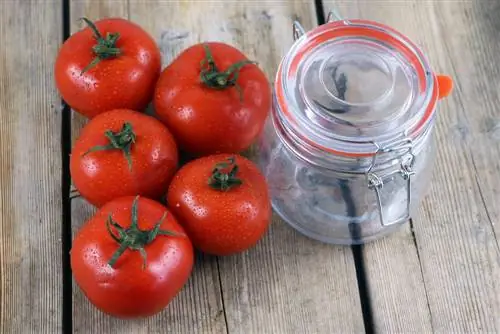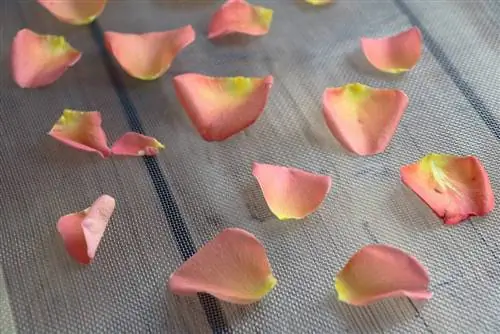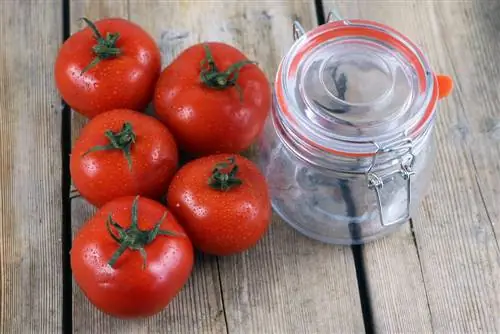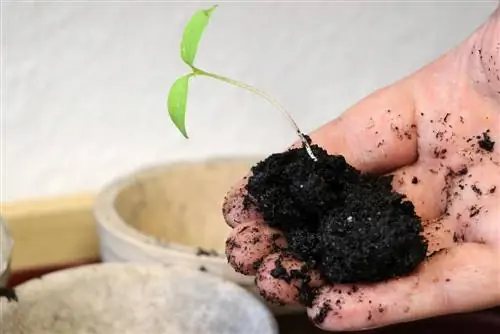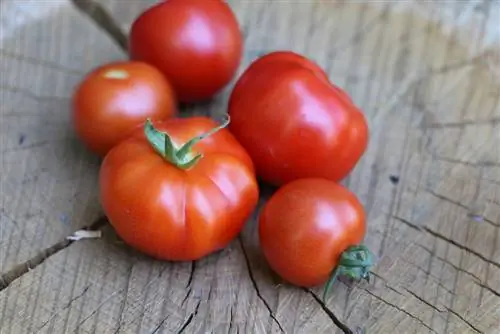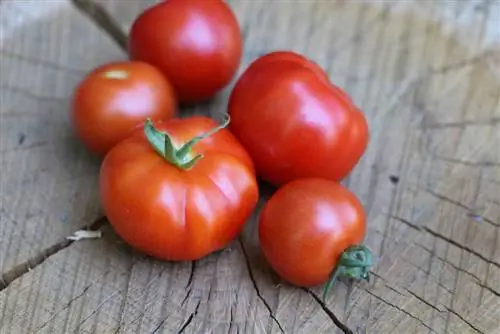- Author admin [email protected].
- Public 2023-12-17 03:39.
- Last modified 2025-06-01 06:48.
Aromatic, he althy and always delicious: Anyone who has ever enjoyed home-grown tomatoes appreciates the benefits of organically grown red vegetables. But many tomato lovers who grow their favorite vegetables over large areas have to ask themselves the question towards the end of the ripening period: How can the supply of tomatoes, which far exceeds the needs of fresh consumption, be preserved?
Preserving tomatoes - options
Fresh tomatoes don't last long - and lose valuable ingredients when stored. If you cannot process a large amount of tomatoes fresh, you will have to resort to preserving the vegetables; There are basically four different options available for this:
- Drying
- Pickling / Preserving
- Preserving
- Freezing
Mediterranean preservation - drying tomatoes
Drying tomatoes is the traditional method of preserving the delicious vegetable. However, if you want to dry your tomatoes, you should wait until the fruits are very ripe and soft; Then the sugar content is particularly high and the tomatoes are also full of flavors that can develop optimally when dried. To prepare the vegetables for drying, the following steps should be followed:
- Opening the tomato with the butterfly cut (this almost splits the vegetable)
- Removing the sap
- Removing the gelatinous seed heads
- Addition of sea s alt
While tomatoes in Mediterranean countries can dry in the warm and dry air, the hobby gardener in our latitudes needs an oven for this process. The tomatoes are generously distributed on a tray that has previously been lined with baking paper. The vegetables are then dried in the oven at 90°C for six hours.
Note
During the drying process, the oven door must not be completely closed; A wooden spoon pushed into the gap between the door prevents moisture from escaping. The tomatoes are sufficiently dried when they can be bent like a tough rubber mass. When you press the tomatoes with two fingers, no more moisture should escape. The vegetables then have to cool down on the baking tray. The tomatoes keep particularly well when stored in a cool, dry place. To extend the shelf life a little, add a few grains of rice to the storage container to absorb excess moisture.
Tip:
If you want to dry vegetables or fruit more often, it may be worth purchasing a professional dehydrator.
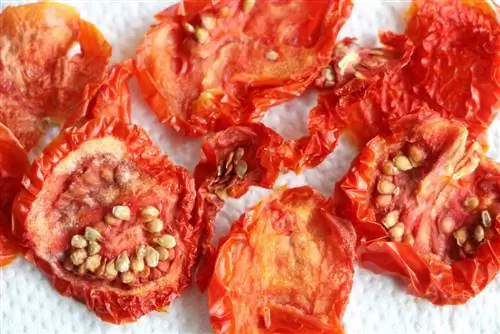
Dried tomatoes not only taste great on their own in antipasti, but can also be further processed, for example by pickling them in olive oil. But pickling is its own method of preservation, which can also be done without drying beforehand.
Pure or as a vegetable cocktail - pickling tomatoes
Selection of tomatoes and storage containers
If you want to pickle he althy vegetables, you need a suitable container and high-quality olive oil, and above all, quality tomatoes that should have the following properties:
- high strength
- robust he alth
- high pulp content
- low number of cores
- Example varieties: Roma tomatoes and beefsteak tomatoes
If you want to preserve your tomatoes in preserving jars or so-called twist-off jars, you should make sure that the containers are rust-free and have no dents. With such glasses, the hobby gardener benefits primarily from the airtight seal. Alternatively, mason jars can also be used. Please note that the rubber rings may only be used once.
It has proven to be a good idea to completely remove the air from the jars before filling. This works with the following method:
- Drizzle the lid with high-percentage alcohol (at least 30%)
- Lighting the lid
- Direct closing of the lid
Sterilizing the preserving jars
In order to increase the standard of hygiene, it is also worth sterilizing the jars. This works, for example, with boiling water. To do this, a large pot is filled with water, into which the jars, lids and rubber rings are then placed. The utensils then have to cook for about 10 minutes. Alternatively, the glasses can also be sterilized in the oven. The following instructions are suitable for this:
- 1. Preheat oven to 140°C
- 2. Place the lids and jars on a baking tray
- 3. Leave the utensils in the oven for 10 minutes
Important note:
The rubber rings must not be put in the oven!
Pickling in olive oil
Once the jars have been sterilized, the actual insertion can be carried out; This works particularly easily with olive oil. To ensure that the finished product not only tastes good but is also he althy, high-quality olive oil should be used. The hobby gardener can recognize this by the following declaration:
- Labeling as “Native Extra”
- Acidity below 0.8%
- grassy, fruity note of the oil
- bitter taste
For the pickling process, the ripe tomatoes are peeled and the skin is slightly cut in one place. The vegetables are then placed in a pot and boiled water is poured over them. After waiting a few minutes, it is easy to remove the skin from the tomatoes. Now the layering can take place in the glass. Alternating with various herbs (for example thyme or rosemary), the tomatoes are poured into the jar; The olive oil can then be added.
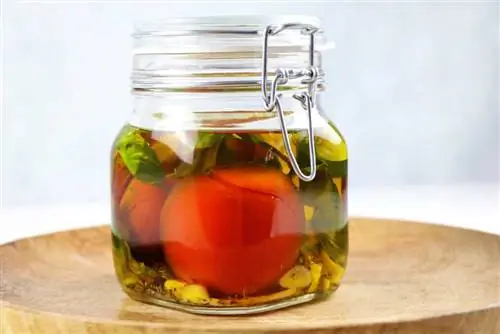
The tomatoes should float in the liquid; However, the vessel must not be filled to the brim. The tightly screwed glasses are then placed in a water bath; To do this, a pot of water and the preserving jar are heated at 85 to 95°C for half an hour. After the jars have cooled, the contents must sit in a cool, dark place for about two weeks.
Preserving - tomatoes for spicy sauces
Preparing the tomatoes
If you have fruits left over from the tomato harvest with slight bruises and cannot use them immediately, you should use them for preserving; Vegetables that are fully ripe are best suited for this purpose. When preserving, the tomatoes are prepared as follows:
- Removing the stem
- Dice the tomatoes
- Slowly bring the tomato pieces to the boil (half an hour without the lid)
- Adding spices like thyme and rosemary
- Addition of s alt
Tip:
Even if some pasta fans find the tomato peel annoying, from a he alth perspective it is still advisable to use it; Tomato peels contain valuable secondary plant substances that protect the immune system.
In the meantime, the hot-rinsed and clean glasses must be provided. When the sauce is ready, it is poured into the glasses. It is important to leave a margin of about one centimeter at the top. The lid is then screwed on tightly; Now the vacuum still has to pull. After the glasses have cooled, they are best stored in a cool cellar.
Note
Before storing, check whether the lid on the screw-top jars is retracted; If you can no longer hear a crack or the lid gives way, the jar is hygienically sealed.
Recipe for preserved tomato sauce
The following ingredients are needed for a spicy tomato sauce:
- 2-3kg tomatoes
- 4 large garlic cloves
- 1 bunch of Mediterranean herbs
- S alt, sweet paprika powder, three pinches of cayenne pepper
- 1 tablespoon sugar
- 1 shot of high-quality olive oil

To prepare it, simmer all the ingredients in a pot without a lid over a low heat for at least half an hour. To break up the shell pieces, puree the sauce. The mixture is then poured into the storage jars as described above. If it is used as a pasta sauce, for example, the sauce can then be freshly refined, for example with garlic, tomato paste and onions. When tomatoes are boiled or pickled, many of the ingredients are already determined in advance. However, if you want to keep as much flexibility as possible when preparing tomato dishes, it is best to choose freezing as the optimal method of preserving tomatoes.
Freezing tomatoes - for maximum nutrient content
Tomatoes can generally be frozen - but this type of preservation is only suitable if the vegetables are to be used later in cooked dishes; because freezing changes the consistency of the pulp. Soups or sauces can be optimally refined with frozen tomatoes.
Basically, tomatoes can be frozen in different ways:
- as a whole
- diced
- in pureed form
Most home gardeners choose the cube shape when they want to freeze tomatoes. When cutting into small pieces, the stalk should also be removed; It is also possible to skin the tomatoes. The vegetable cubes are then portioned into small freezer bags, which ideally have a zipper; In this way the contents are sealed airtight. This not only allows you to increase the packing density - the tomatoes also thaw more easily later. Now the frozen food can be placed in the freezer; Here it can be kept for up to a year.
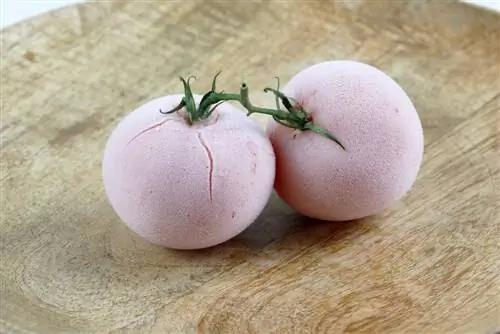
Whether frozen, dried, pickled or cooked - processing tomatoes from your own cultivation is always worth it. In this way, hobby gardeners not only always have the right ingredients for pasta, pizza or soups at hand - but they also do something for their he alth at the same time - for a long gardening life!

